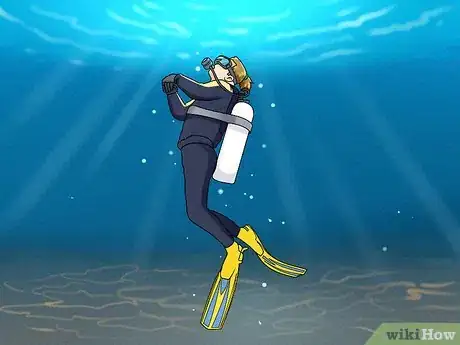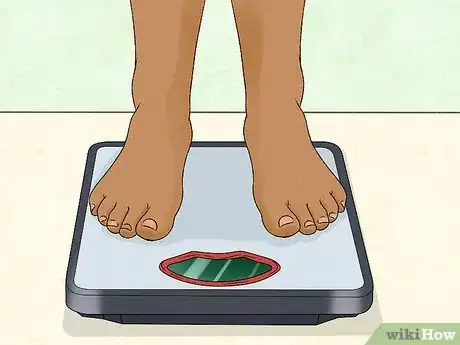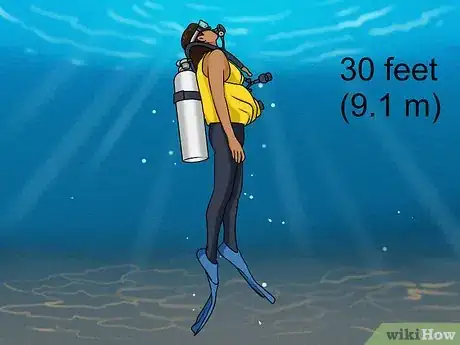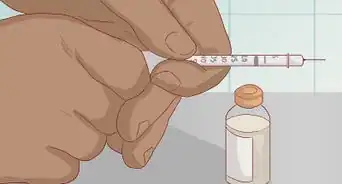This article was co-authored by wikiHow staff writer, Eric McClure. Eric McClure is an editing fellow at wikiHow where he has been editing, researching, and creating content since 2019. A former educator and poet, his work has appeared in Carcinogenic Poetry, Shot Glass Journal, Prairie Margins, and The Rusty Nail. His digital chapbook, The Internet, was also published in TL;DR Magazine. He was the winner of the Paul Carroll award for outstanding achievement in creative writing in 2014, and he was a featured reader at the Poetry Foundation’s Open Door Reading Series in 2015. Eric holds a BA in English from the University of Illinois at Chicago, and an MEd in secondary education from DePaul University.
There are 18 references cited in this article, which can be found at the bottom of the page.
This article has been viewed 16,975 times.
Learn more...
The bends, also known as decompression sickness (DCS) or decompression illness (DCI), are a condition caused by a rapid change in pressure. It’s mainly a concern for scuba divers as they surface, and it can cause some nasty symptoms if you don’t take the proper precautions to give your body time to acclimate to the changes in pressure as you swim up. The good news is that if you’re going scuba diving, you’ll have an instructor or diving buddy with you who will be trained on how to prevent the bends, since decompression is a key component of getting a scuba certification.[1]
Steps
What are the bends?
-
1It’s a medical condition triggered by swimming up too quickly. When you go diving, you breathe compressed air that has a lot of nitrogen in it. Your body experiences pressure underwater, and the nitrogen filters through your body safely because of that excess pressure. But if you swim to the surface too quickly, the nitrogen won’t have time to dissipate into your bloodstream and it can start to form bubbles. Those bubbles lead to all kinds of problems that are collectively known as the bends.[2]
- The bends are also a risk if you’re in tunnel construction, mineral mining, or space exploration. It can also be a risk during depressurized flights. Luckily, these aren’t everyday occurrences and you’ll learn how to prevent the bends before you’re even allowed to do any of these things anyway.[3]
-
2Symptoms include joint pain, fatigue, and ear or sinus pain. If you swim to the surface too quickly and you get the bends, you may have an odd pain in your ears, nose, or mouth. You may get itchy, and you’ll likely feel intense pain in your joints. You may also get extremely tired, run out of breath, get dizzy, or find it difficult to move. If you experience any of these symptoms after diving, see a doctor immediately.[4]
- In extreme cases, you may become paralyzed, lose control of your bladder, or pass out.[5] You may also have trouble seeing, or feel confused.[6]
- The bends are extremely dangerous if they aren’t treated, so do not hesitate to go to the emergency room if you suspect you may be experiencing the bends—even if your symptoms are minor.[7]
How do I prevent the bends?
-
1Use a dive table to take breaks on your way up to the surface. You can prevent the bends entirely by swimming up to the surface in sections and taking a short break in between each layer. How long you pause at each distance depends entirely on how deep you are and how long you’ve been diving. This is why people always bring a dive table with them underwater. A dive table is just a reference sheet containing all of the information you’ll need to know where to stop and for how long.[10]
- Dive tables are standardized—there aren’t different tables for different people. You should never go diving without one! If you’re new to diving, your instructor or partner should have a dive table with them.[11] You’ll also learn how to read a dive table if you’re earning your scuba certification![12]
- As an extremely basic rule of thumb, you should stop roughly every 15 feet (4.6 m) for 5 minutes at a time. The slower you go, the safer it will be![13]
- Most dive computers have these tables built into the software.[14]
-
2Do not go diving if you have a hernia, heart defect, or asthma. Certain conditions may make you uniquely vulnerable to the bends. If you have an untreated hernia, diving may cause gas inside of your hernia to expand, which can contribute to the bends. People with heart defects and asthma are also uniquely susceptible to pressure changes, and you should not dive if you have any of these conditions.[15]
- While it isn’t related to the bends, you should be mindful of diving if you have diabetes, since the pressure can cause your blood glucose levels to swing wildly.
-
3Skip the dive session if you have a cold, cough, or chest infection. Colds, coughs, and chest issues can cause mucus buildups in your lungs and sinuses. The pressure your body experiences underwater can make these problems worse, and it will be harder to breathe comfortably as you swim back to the surface. Just to be safe, don’t dive if you’ve got any kind of breathing or sinus issue.[16]
- If you have any trouble breathing, it will be harder for you to get the oxygen you need to filter out the nitrogen in time.
How do I minimize my risk of getting the bends?
-
1Maintaining a healthy weight will minimize your risk. People who are overweight or obese are actually more likely to get the bends. It’s thought that excess body fat makes it harder to get rid of all of the nitrogen. Maintaining a healthy BMI can help reduce your risk.[17]
- The most important thing you can do to prevent the bends is follow your dive table and take it slow on your way up. Maintaining a healthy BMI decreases your risk, but it isn’t a replacement for following safety protocols.
-
2Never go diving if you’ve been drinking alcohol. Since alcohol increases your circulation and lowers blood pressure, it takes a lot longer for the nitrogen in your blood to filter out. This can render the diving table recommendations inadequate, and you’ll have a higher risk of running into decompression sickness if you’ve been drinking.[18]
-
3Swap your standard gas mixture out for EANx (Nitrox). EANx, popularly known as Nitrox, contains a lower amount of nitrogen. This can dramatically decrease the odds you get the bends.[19]
- The main downside of EANx is that it’s more expensive than the standard diving gas mixtures.
-
4Take extended breaks in between your dives. The longer you can wait in between diving sessions, the more time your body will have to process all of the leftover nitrogen. If you’re going deeper than 10–20 feet (3.0–6.1 m) on daily dives, take at least one day off a week.[20]
- This is especially important if you’re a diving instructor. Many cases of decompression sickness occur because instructors don’t take enough time off in between classes. It’s easy to skip breaks the more seasoned of a diver you become, but it’s super important to take long breaks in between sessions.[21]
- If you ever do get the bends, wait at least 30 days after your recovery before diving again.[22]
- All of this will help minimize the odds you get the bends, but they aren’t replacements for taking decompression breaks while you’re swimming up to the surface. That’s the only way to 100% prevent the bends.
At what depth do the bends occur?
-
1Most often, the bends are a real concern after 30 feet (9.1 m). The deeper you go, the more likely you are to run into the bends if you surface too quickly. Once you dive deeper than 30 feet (9.1 m), the bends become a serious potential problem. Do not ignore your dive tables, pay close attention to your pressure gauge, and time your decompression breaks carefully as you surface.[23]
- This is why diving tables typically start at 35 feet (11 m). If you’ve been swimming in water that’s 30–35 feet (9.1–10.7 m) deep but not further than that, just use the instructions for 35 feet (11 m) to surface safely.
-
2It’s rare, but the bends can occur at 10–20 feet (3.0–6.1 m). The bends generally aren’t a concern unless you go deeper than 30 feet (9.1 m), but the amount of time you spend in the water is a big factor here. If you’re diving in shallow water that’s deeper than 10 feet (3.0 m) for more than 30 minutes, you could potentially run into the bends if you surface too quickly. Swim up slowly and take a 5-minute break when you’re 5 feet (1.5 m) from the surface just to be safe if you’ve been in shallow water for a while.[24] [25]
- It’s exceptionally rare for the bends to occur in water shallower than 30 feet (9.1 m), so don’t panic if you haven’t been taking decompression breaks on the shallow dives you’ve completed in the past. If you’ve never had symptoms before, you have nothing to worry about.
References
- ↑ https://www.tdisdi.com/wp-content/uploads/files/sandp/currentYear/SDI/part%202/pdf/individual/SDI%20Diver%20Standards_07_Open_Water_Scuba_Diver.pdf
- ↑ https://www.health.harvard.edu/a_to_z/decompression-sickness-a-to-z
- ↑ https://www.cdc.gov/niosh/topics/decompression/default.html
- ↑ https://www.uofmhealth.org/health-library/abo0894
- ↑ https://www.cdc.gov/niosh/topics/decompression/default.html
- ↑ https://www.uofmhealth.org/health-library/abo0894
- ↑ https://www.uofmhealth.org/health-library/abo0894
- ↑ https://www.australiangeographic.com.au/topics/science-environment/2012/08/the-bends-anatomy-of-decompression-sickness/
- ↑ https://www.health.harvard.edu/a_to_z/decompression-sickness-a-to-z
- ↑ https://www.health.harvard.edu/a_to_z/decompression-sickness-a-to-z
- ↑ https://www.osha.gov/laws-regs/regulations/standardnumber/1926/1926SubpartSAppA
- ↑ https://www.uofmhealth.org/health-library/abo0894
- ↑ https://www.sportdiver.com/sportdiver-premium-how-to-avoid-DCS-bends
- ↑ https://www.similandivingtours.com/blog/blogs/information/dcs-the-most-common-serious-diving-injury-is-often-called-the-bends
- ↑ https://www.health.harvard.edu/a_to_z/decompression-sickness-a-to-z
- ↑ https://www.nhs.uk/conditions/air-embolism/
- ↑ https://pubmed.ncbi.nlm.nih.gov/30241124/
- ↑ https://dtmag.com/thelibrary/alcohol-nicotine-divers-know/
- ↑ https://www.sportdiver.com/sportdiver-premium-how-to-avoid-DCS-bends
- ↑ https://www.sportdiver.com/sportdiver-premium-how-to-avoid-DCS-bends
- ↑ https://pubmed.ncbi.nlm.nih.gov/12964853/
- ↑ https://www.scubadiving.com/how-long-should-you-wait-to-scuba-diving-after-getting-dcs-aka-bends
- ↑ https://www.scubadivingearth.com/how-deep-can-you-dive-without-decompression-no-decompression-stop-limits/
- ↑ https://www.undercurrent.org/UCnow/dive_magazine/1998/ShallowWaterBends199810.html
- ↑ https://www.theguardian.com/lifeandstyle/2011/jun/18/i-got-the-bends
- ↑ https://www.health.harvard.edu/a_to_z/decompression-sickness-a-to-z
- ↑ https://www.hopkinsmedicine.org/health/treatment-tests-and-therapies/hyperbaric-oxygen-therapy-for-wound-healing
- ↑ http://midlandsdivingchamber.co.uk/index.php?id=dci&page=11
- ↑ https://www.health.harvard.edu/a_to_z/decompression-sickness-a-to-z
- ↑ https://www.australiangeographic.com.au/topics/science-environment/2012/08/the-bends-anatomy-of-decompression-sickness/








































































